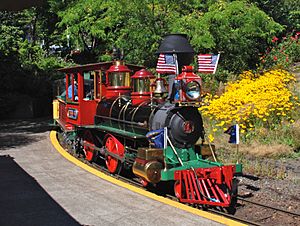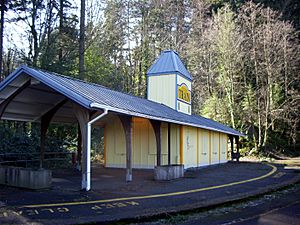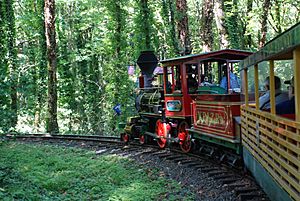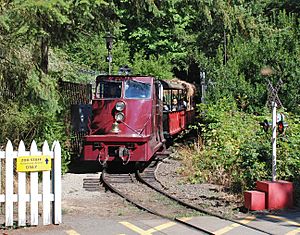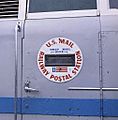Washington Park and Zoo Railway facts for kids
Quick facts for kids Washington Park & Zoo Railway |
|
|---|---|
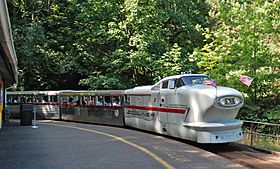
The Zooliner, shown arriving at Washington Park station, is one of the railway's two primary trains.
|
|
| Overview | |
| Owner | City of Portland, leased to Metro (Oregon regional government) |
| Locale | Portland, Oregon |
| Service | |
| Ridership | Approx. 350,000 annually |
| History | |
| Opened | June 7, 1958 (officially June 9) |
| Technical | |
| Track gauge | 2 ft 6 in (762 mm) |
|
Portland Zoo Railway Historic District
|
|
| Location | Portland, Oregon |
| NRHP reference No. | 100005018 |
| Added to NRHP | March 5, 2020 |
The Washington Park & Zoo Railway (WP&ZRy) is a fun, narrow-gauge train ride in Portland, Oregon. It's located in Washington Park and uses trains that are 5/8 the size of real ones.
This railway first opened in parts between 1958 and 1960. It used to connect the Oregon Zoo, Hoyt Arboretum, International Rose Test Garden, and the World Forestry Center. The longer track through Washington Park is about 2 miles (3.2 km) long, but it is not currently in use.
Today, the train operates on a shorter, half-mile (0.8 km) loop only inside the Oregon Zoo. About 350,000 people ride the train each year. It runs all year when the zoo is open, except for a short time in winter for maintenance. You need a special ticket to ride the train, plus zoo admission.
In 2013, the train stopped running for a while. This was because the zoo was building a new elephant area. A new track was built, and the train started running again on the new Zoo Loop line in November 2014.
Contents
History of the Zoo Railway
The railway was first called the Portland Zoo Railway. Its first section, about 1.2 miles (1.9 km) long, opened on June 7, 1958. This was before the zoo fully opened at its new location. The Zooliner was the first train to run on this line.
In 1959, the railway had trains running in two places. The Oregon steam train and the Zooliner carried passengers at the Oregon Centennial Exposition. This was a big fair held in North Portland.
After the fair ended in September 1959, these two trains moved to the new zoo line. In May 1960, the railway added a 1.4-mile (2.3 km) extension. This new track went through Washington Park to a station near the Rose Gardens. The small station building itself was also moved from the Centennial Exposition.
The railway's name changed to the Washington Park and Zoo Railway in 1978. This happened after the zoo's name changed to Washington Park Zoo. Even when the zoo became the Oregon Zoo in 1998, the railway kept its name.
The train line also served the Oregon Museum of Science and Industry from 1958 to 1992. That museum was located near the zoo back then.
In 2018, many people signed an online petition. They wanted to save the "long route" that goes from the zoo to the Rose Garden. This route was part of a plan to be removed and replaced with a walking path. As of 2023, the longer route is still there, but not in use.
In 2020, the railway was added to the National Register of Historic Places. It was recognized as a historic district called the Portland Zoo Railway Historic District. This included the Zooliner, the Oregon steam locomotive, their passenger cars, the tracks, and the stations.
Train Routes and Journeys
The longer Washington Park route used to offer a 35-40 minute round trip. It ran through the woods of Washington Park and the zoo grounds. However, this route has not been running since late 2013. It needs repairs because of small landslides on the track.
The Zoo station is close to the zoo entrance. The Washington Park station, near the Rose Garden, is still in good shape but closed. It's a short walk from the International Rose Test Garden and Portland Japanese Garden.
When the longer route is not running, the 10-12 minute Zoo Loop trip operates. This trip stays only within the Oregon Zoo grounds. The Zoo Loop is mostly a one-way track. The longer 2-mile (3.2 km) line through Washington Park has one main track but also has special sections called "sidings." These sidings allow trains going in different directions to pass each other. All these tracks are still in place, even if they are not being used.
The Trains You Can Ride
The Washington Park and Zoo Railway has three main trains that usually run. These are the Zooliner No. 2, the 4-4-0 No. 1 Oregon (the original steam train), and the Oregon Express No. 5. Two of these trains are smaller versions of real, famous trains. There are also two smaller locomotives used for maintenance, not for passengers.
Most of the time, especially on weekdays, only the two diesel trains run. The steam train, Oregon, runs only on a few special weekends each year and for events like "Zoo Lights" during the holidays. Some trains have special lifts to help people in wheelchairs get on board.
The Zooliner No. 2
The Zooliner is a 5/8-scale copy of the Aerotrain. The Aerotrain was known for its cool, futuristic design, like a car from the 1950s. The Zooliner was built in 1958. Its body was made by a company in Portland.
The Zooliner was first powered by a 140-horsepower diesel engine. Now, it has a 165-horsepower diesel engine. It is called locomotive No. 2. The train has four or five sleek passenger cars that match the locomotive.
4-4-0 No. 1, Oregon
The 4-4-0 No. 1 Oregon is a 5/8-scale copy of a classic American steam locomotive from the 1800s. It was built in 1959. It looks like the Reno locomotive from Nevada's Virginia & Truckee Railroad.
Unlike the original, the Oregon uses oil for fuel, but it is a real steam engine. It weighs about 8 tons. It first carried passengers in June 1959 at the Centennial Exposition. Later that year, it moved to the new zoo. This locomotive has four passenger cars that look like old open-air cars.
The Oregon needed many repairs over the years. It was taken out of service in 2002 but was fixed up and returned in 2004 thanks to donations. Today, it usually runs on busy weekends like Memorial Day and Labor Day, and during the "Zoo Lights" event.
The Oregon Express No. 5
The Oregon Express is different because it's not a copy of a real train. Its diesel locomotive is No. 5. It was built in the 1940s and bought by the zoo in 1958. It was first used to help build the original track at the zoo.
At first, it was made to look like a steam train and called the Circus Train. Over time, it was rebuilt to look more modern. Its colors and name have changed several times, from Casey Pioneer to Circus Train, then Astroliner, Orient Express, and finally the Oregon Express. This train also has four passenger cars.
Other Locomotives
Locomotives No. 3 and No. 6 are small industrial diesel engines. They are not used for carrying passengers. Instead, they help with track maintenance and moving cars around the yard. If needed, they can pull the passenger cars of the Oregon Express or Oregon trains.
Mail Service on the Railway
The Washington Park & Zoo Railway carries U.S. mail! It was one of the first fun railways to have its own postmark. It is also the last railway in the United States to continuously offer hand-canceling and processing of mail.
The U.S. Postal Service gave the railway its special cancellation stamp in 1961. The Zooliner locomotive has a mail slot on its side. There are also mailboxes at the Zoo and Washington Park stations where you can drop off letters.
Images for kids
See also
- Amusement rides on the National Register of Historic Places
- Railway Mail Service


